What became Bell Features Publications Limited of Canada started in the summer of 1941 with the first issue of a title called Wow Comics, cover-dated September 1941. This was an ambitious project that turned out to be Canada’s first full-colour comic book.
The company that put it out was actually a sign painting company called Commercial Signs of Canada, founded a dozen years earlier by two brothers: Cyril and Eugene Bell. Both had been born in Peterborough to Norman and Bessie Bell. Cyril (Cy) on October 2, 1904, and Eugene (Gene) in December of 1908. By the time Cy was six, the family relocated to Toronto where Cy’s father worked as an Electrician for the local Streets and Railways company.
Commercial Signs of Canada produced hand-crafted signage for billboards, storefronts, banners, and street cars. This skill was a valued one in the days before computer image production.
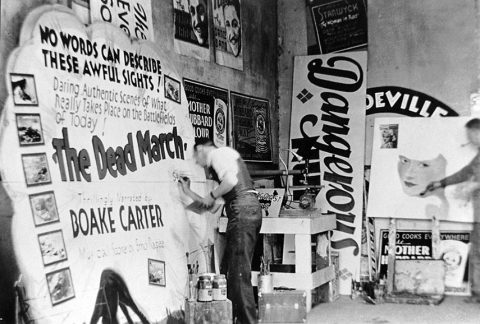
Alexander Ross’ article “A fond portrait of those wild wartime comics” in the September 19, 1964 issue of Maclean’s Magazine, tells us that “Bell happened to have a small colour press in his sign-painting shop which was used occasionally for printing billboards and banners for used-car lots.” But, what were the catalysts that persuaded Cy Bell to print that first full-colour Canadian comic book? Of course, the banning of American comics from entering Canada in late 1940 was one, but the other was Edmund T. Legault.
There are slightly conflicting statements as to how Edmund Legault, the eventual creator/artist for that first issue of Wow Comics came into the picture. In that same 1964 Maclean’s article, Ross (p. 29) goes on to state the following:
When one of his sign-painters, Edmund Legault, revealed that his secret ambition was to become a newspaper cartoonist, and that in his spare time he’d created a comic strip called Dart Daring and drawn several months of episodes, Bell decided to put his little press to work and ran off fifty-two thousand copies of a Dart Daring comic book [presumably Wow Comics No. 1].
John Bell gives a slightly different account which appears in both his Canuck Comics (Matrix 1986 p. 25) and Invaders from the North (Dundurn 2006 p. 48):
In 1939, [the Bells] had been approached by a French Canadian artist, Edmund Legault, who hoped to find a publisher for his comic art. The Bells were forced to turn Legault away. However, late in 1940, when Cy Bell learned of the impending ban on U.S. comics, he re-established contact with Legault, acquired capital from businessman John Ezrin, and began work on an adventure comic book, Wow Comics.
So in the Ross version, Legault was an employee of Commercial Signs of Canada who approached Cy Bell with the idea and ready-made artwork for a comic book and in the John Bell version Legault was never a Commercial Signs employee but was re-contacted after having unsuccessfully approached Cy Bell with the idea for a comic book. Whichever version is closer to what really happened, the creative force behind Wow Comics No. 1 was Edmund Legault. He drew and wrote 95% of it.
Bell printed 52,000 copies of Wow Comics No. 1 and it sold out within a week and at least one more set of 50,000 copies was printed. One curious thing was that Fawcett had already published at least 2 issues of its own title called Wow Comics south of the border featuring a hero called Mr. Scarlet. Cy Bell was either unaware of it or was unconcerned of any legal repercussions.
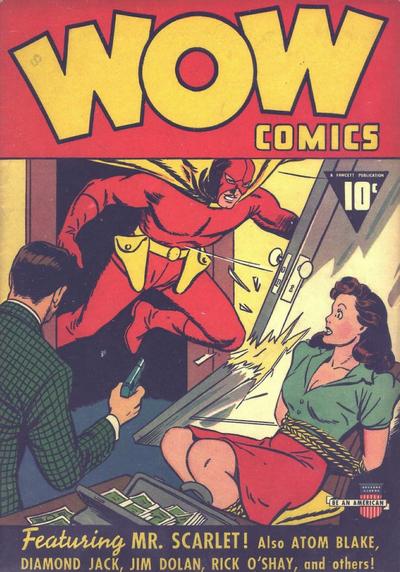
Fawcett’s Wow 1 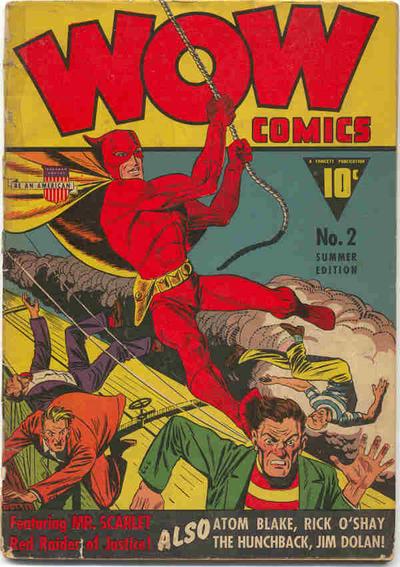
Fawcett’s Wow 2
Wow Comics No. 1 was 64 pages of full-colour comic and was the second Canadian 15¢ comic. It had this price point on the first eight issues (the first eight issues of Maple Leaf’s Better Comics were also 15¢). Its cover showed a blond buccaneer skewering a pirate through the chest while a number of bloodied blades threatened from around the edges of the book. The image is untypical for Canadian wartime comics, which consciously avoided any lurid quality such as the depiction of blood–that was reserved for the pulps. Cy Bell probably put the breaks on this sort of thing after the second issue, which also had a cover that showed a blood-dripping cutlass dispatching a native warrior. The name of that blond hero was Dartner Daring, an 18th century master swordsman. There’s also a banner along the bottom edge of the cover displaying the book’s second feature, a science fiction adventure involving a character called Whiz Wallace.
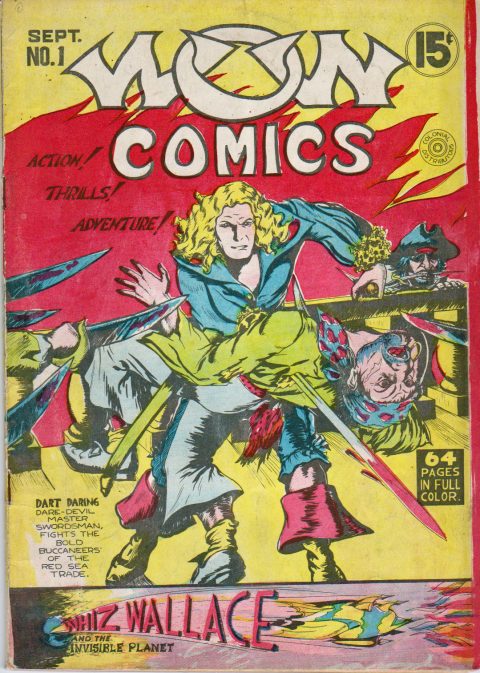
Dart begins his story shipwrecked on a South Pacific island where he finds a treasure, encounters, fights, and makes friends with a gorilla, and then rescues young Lorraine Knight from cannibals.
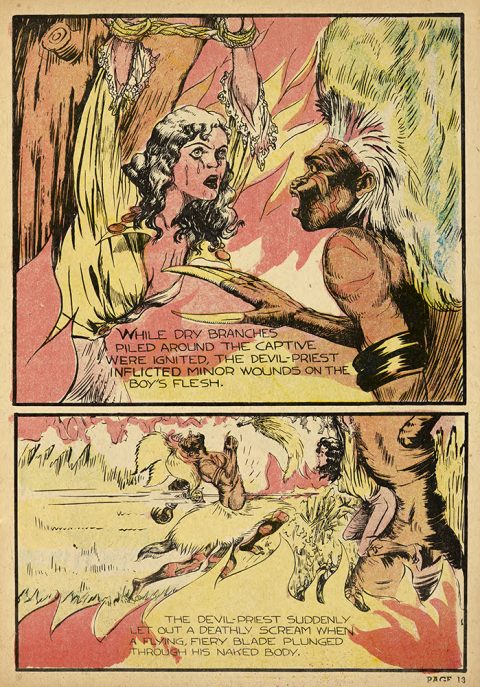
By issue three, after encountering pirates and leaving the island, we find out that Dart is the son of the pirate Captain Kidd and that Lorraine, his love interest, is also the daughter of a pirate. With issue four, Dart and Lorraine have made it to the west coast of Canada. In the following issues, the pair encounter various characters and fight natives and wildlife while making their way east to the Rocky Mountains. By the first black-and-white issue, No. 9, they cross the Rockies and make it to the plains of Canada. In issue No. 10 Dart and Lorraine are back in the Pacific fighting pirates.
Though that first issue was in full-colour, the second had only blue and orange and subsequent issues up to No. 8 were only two-colour, before going black-and-white for the rest of the run.
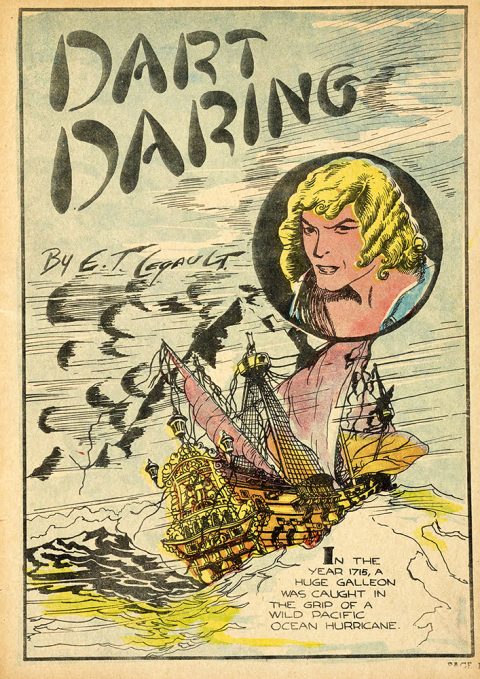
Splash from Wow 1. 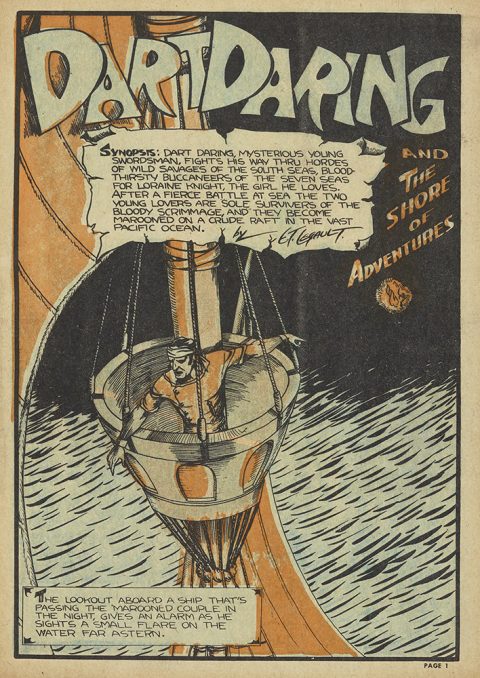
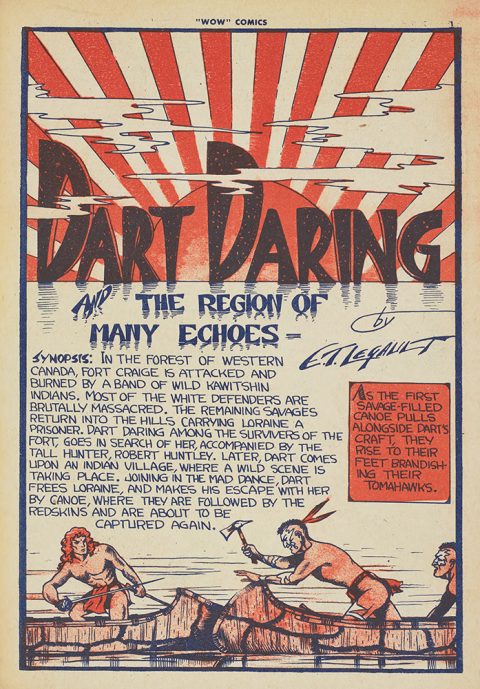
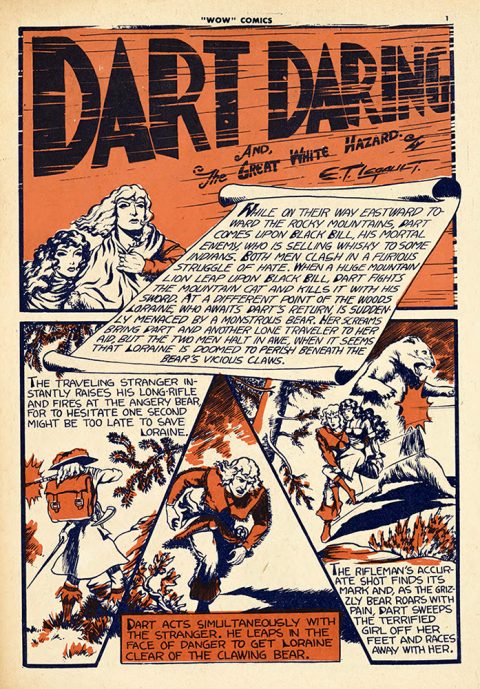
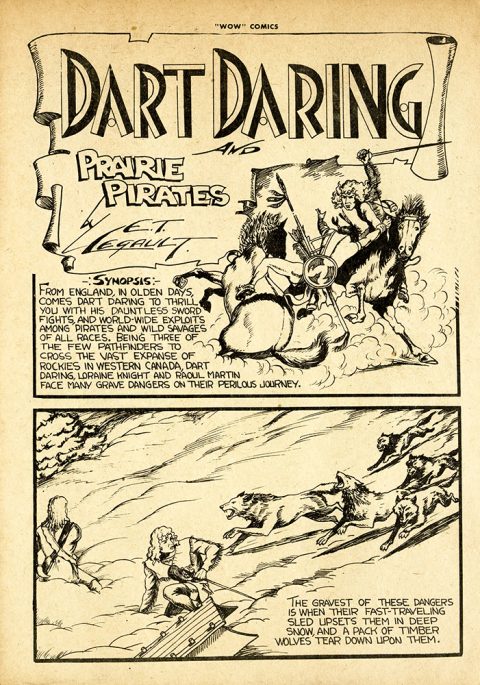
Dart Daring’s run continues for seven more issues and in them, he gets a sort of sidekick in the form of a young boy named Franklin. He also meets up with Blackbeard. His last appearance is in Wow 17 where he, Lorraine, and Franklin are in Central America. In the last panel in that issue, we are left hanging with young Franklin bound and being carried off for human sacrifice by Aztec-like natives.
Legault’s other feature in that first issue of Wow Comics was about an American air racer, Whiz Wallace, whisked away to a strange ‘invisible’ planet called Vezara à la Flash Gordon. The story begins with Whiz participating in an air race on the outskirts of New York City. He encounters a scaly humanoid behemoth lumbering across the countryside who plucks Whiz’s plane right out of the sky. The monster also reaches down to the highway and scoops up a car with a girl in it, then returns carrying both victims to a rocket ship. Whiz wakes up in the rocket ship unable to move, realizing that it is shooting into space. He also sees the girl who had been in the car being prepared for sacrifice by a large, human-like alien. Suffice it to say that Whiz rescues the girl, named Elaine Kenyon, who then serves as his Dale Arden when they land on Vezara at the end of the story.
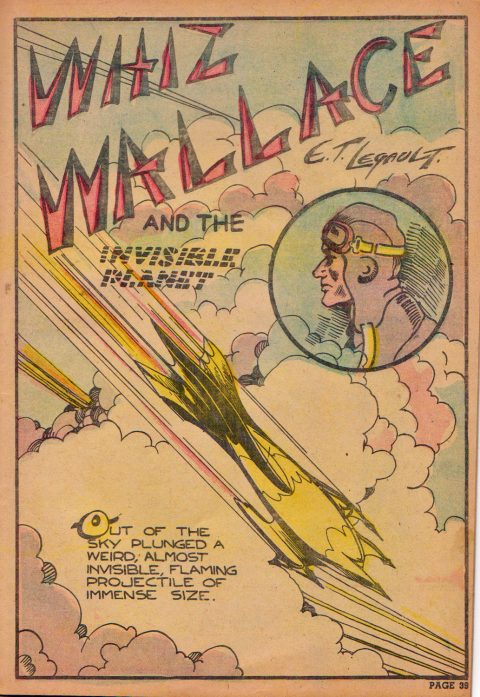
Splash from Wow 1. 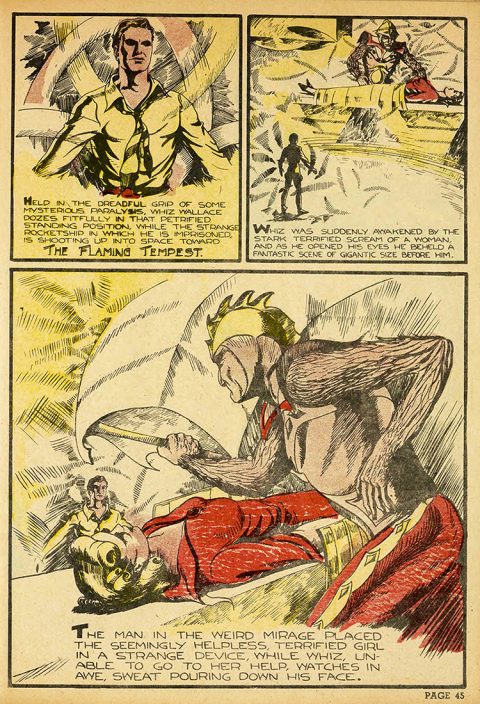
Elaine Kenyon in peril.
Whiz battles creature after creature on this ‘invisible’ planet called Vezara for the next nine issues, until Wow Comics No. 10, when he returns to earth and becomes a test pilot for the American War Department. He is given the commission of Flight Commander in the U.S. Air Force and begins another series of adventures across Africa and the Middle East all with Elaine Kenyon in tow.
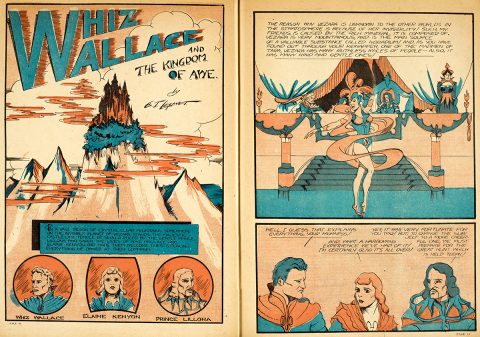
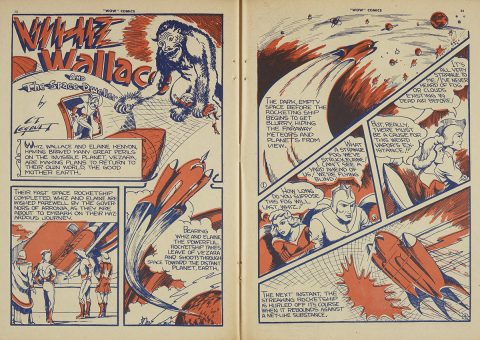
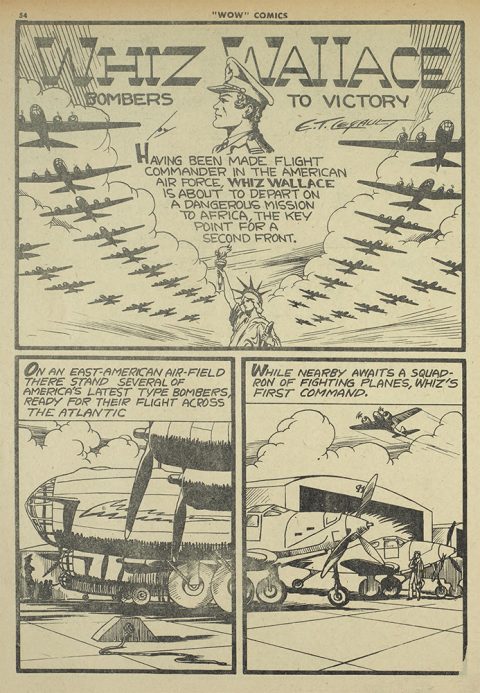
Just like with Dart Daring, Whiz Wallace’s strip ends in Wow Comics No. 17, most likely because Edmund Legault was drafted. But, the difference with Whiz is that this strip was taken over by another cartoonist, Harry Thomson, for issues No. 16 and 17. Thomson, who also did the Ace Bradley strip in Commando Comics from issue No. 7 on, proceeds to take it on an abrupt right-angle turn.
When Thomson received the assignment, Whiz and Elaine had been captured by Nazis and onboard a Nazi Bomber flying out of North Africa for Germany. His solution for this cliff-hanger was to have the bomber run out of gas and the Nazis decide to land in Cairo and give themselves up to get out of the rest of the war. But, after receiving a name-check in the recap in the splash panel, Elaine is forgotten about or jettisoned, and Thomson sends Whiz off to Bombay in pursuit of a villain called the Spymaster. There he meets a new female interest in reporter Jo Barry and, with the help of an Indian dancing girl, the two manage to foil the Japanese Spymaster’s scheme. With that, the Whiz Wallace saga comes to an end.
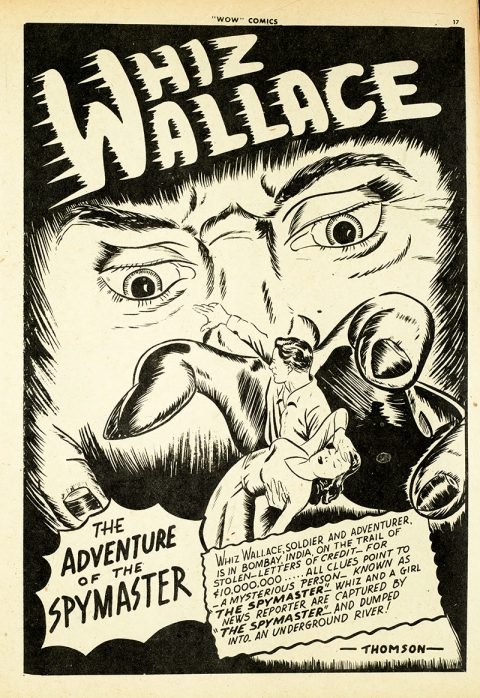
Edmund Legault got Bell Features’ Wow Comics off the ground and just about single-handedly supplied its content for the first half-dozen issues, including doing those first six covers. His two series, “Dart Daring” and “Whiz Wallace,” continued for just over half the title’s run of 30 issues. He was certainly a central figure in the early history of Canadian war time comics. It mustn’t be forgotten that he also created the characters of Dixon of the Mounted and Thunderfist in Active Comics, drawing the first two appearances of the former while Murray Karn was the artist for the latter.
The odd thing is that he is one of those figures in Canadian wartime comics that we know almost nothing about apart from the product on the page to which he leant his signature. In Joke Comics No. 23, which probably came out a month or two after VE Day, Cy Bell and Adrian Dingle decided to acknowledge some of the Bell Features employees who had served in the military and were now returning home. Among the statements on that two-page spread is the following concerning Legault: “Gun crew member of the Royal Canadian Artillery. Ed’s strips were “Dart Daring” and Whiz Wallace.” Trained at Valleyfield, Quebec.” However, that’s the extent of the biographic information we have on the artist. Let’s hope that this can be remedied in the near future.
To finish up, I’d like to mention some of the highlights of the 30-issue run of Wow Comics after those Legault-filled first six issues.
It was with Wow No. 7 that the Bell logo first appeared on the covers of the title. This was because Cy Bell had changed the name of the comic book publishing company from Commercial Signs of Canada to Bell Features and Publishing Company Limited in the spring of 1942. It was also with Wow No. 7 that the title started to diversify with the introduction of a new feature about a ‘Jungle Jim’ type Amazonian adventurer called Jeff Waring, created, written, and drawn by Murray Karn. Though Jeff Waring is the central figure on the cover of this book—the first Wow Comics cover not drawn by Edmund Legault but by John Hilkert, the creator of The Wing in Joke Comics—Waring doesn’t actually appear in that first story other than in the splash panel of the story.
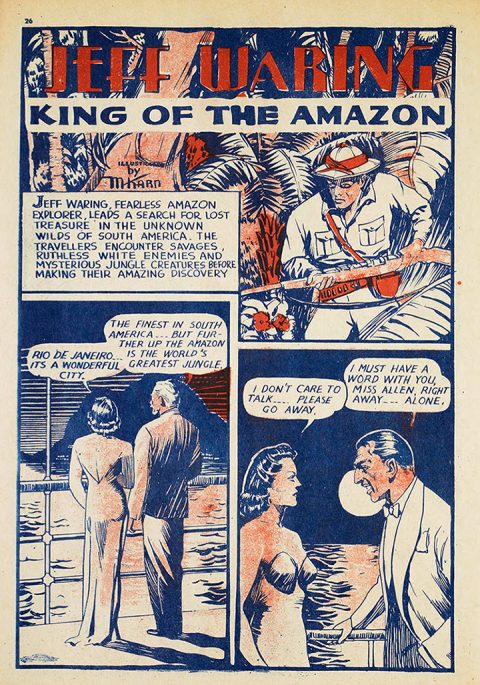
Wow Comics No. 8 begins a series of seven covers done by Edmond Good and introduces young Jack Tremblay’s Canadian fighter pilot hero, Crash Carson. In issue 15 Adrian Dingle creates tuxedoed crime fighter The Penguin and with issue 16 begins doing the rest of the covers in the series except for the last which was done by Fred Kelly. That issue, Wow Comics No. 16, also has the first appearances of René Kulbach’s western hero, The Phantom Rider, and Dingle’s secret agent, Guy Powers.
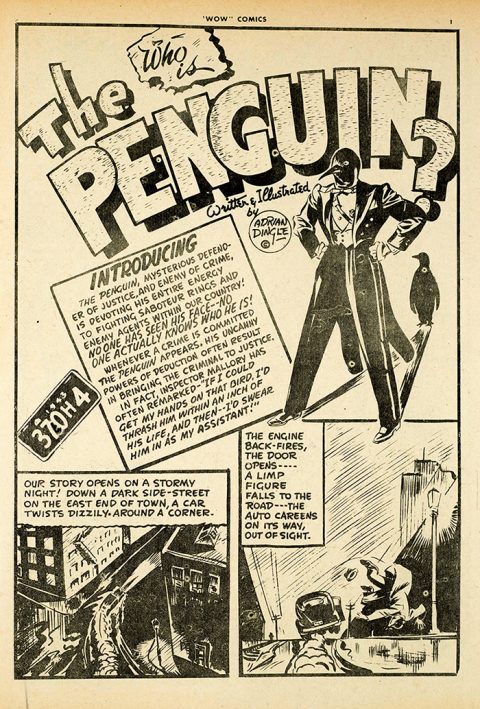
Wow Comics No. 17 is significant because it contains the first professional work of a sixteen-year-old Jerry Lazare as he takes over the Jeff Waring strip after Murray Karn leaves to serve in the Medical Corps. The irony of this is that Jerry very first published page (that Jeff Waring splash page in Wow Comics No. 17) is actually a swipe of Lou Fine’s cover from Fight Comics No. 3 which had come out (cover date of March 1940) before the ban on American comics. Jerry must have had one stashed in the back of his closet somewhere, but it did kickstart a long career in illustration and eventually fine art.
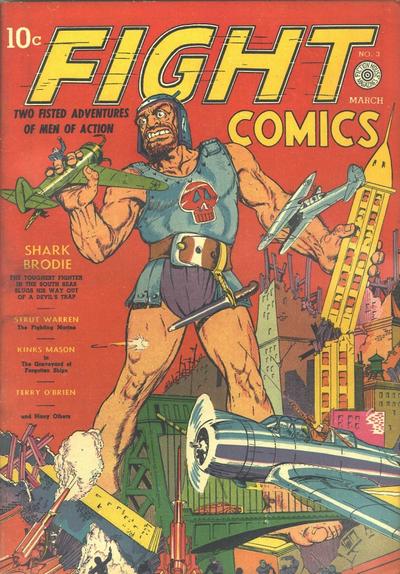
Lou Fine’s 1940 cover. 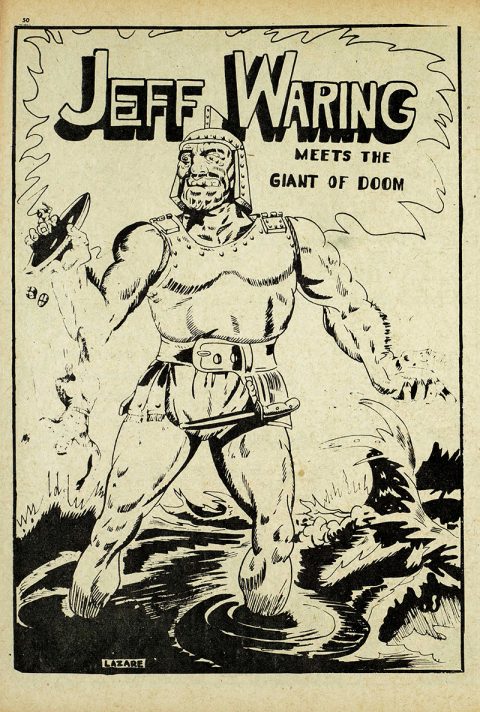
Jerry Lazare’s splash from Wow 17.
As an aside, I did have my copy of Wow Comics No. 17 signed by Gerald Lazare and had that signature authenticated by CGC on-site at Fan Expo 2018. However, after having it sent in for grading and getting the result below back, it does make one think what sort of comic knowledge CGC expects of its graders or perhaps that the American-centric nature of comic collecting has just overwhelmed the hobby.
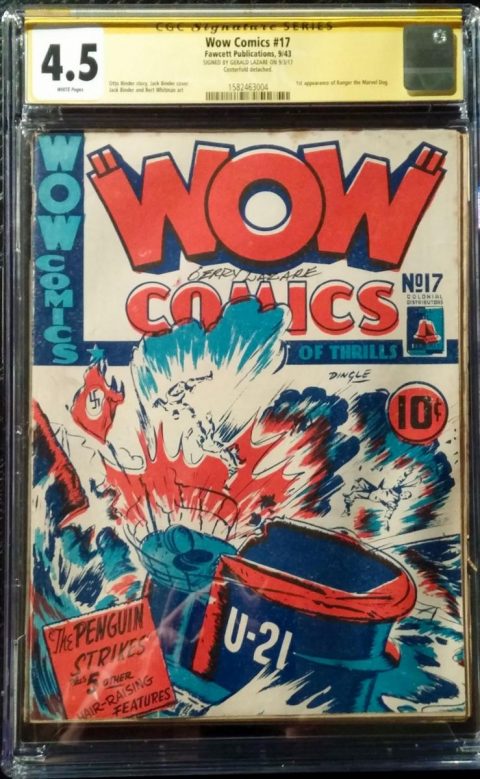
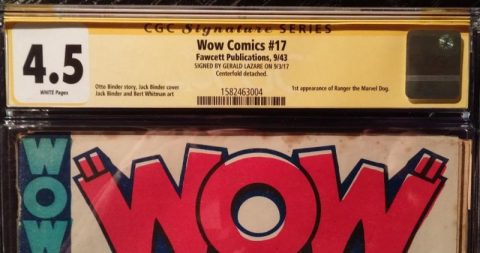
The rest of the Wow Comics run produces first appearances of Aram Alexanian’s Blackhawk swipe, The Black Falcon, in issue 19, Tedd Steele’s cartoony Woody and the Wolf in issue 23, Fred Kelly’s race track wonder, Clip Curtis, and Jerry Lazare’s The Dreamer both in issue 24.
Finally, one of the most significant first appearances in Canadian wartime comics is that of Fred Kelly’s Doc Stearne in Wow Comics No. 26–the issue with the iconic Dingle image of The Dreamer running straight out of the cover at you (which I used for the cover of my book on Bell Features artists: Heroes of the Home Front). Doctor Jim Stearne is a Canadian physician, and in the final four issues of Wow Comics, encounters a handful of strange civilizations and a Japanese expeditionary force in an extinct volcano and its environs in the northern reaches of Canada.
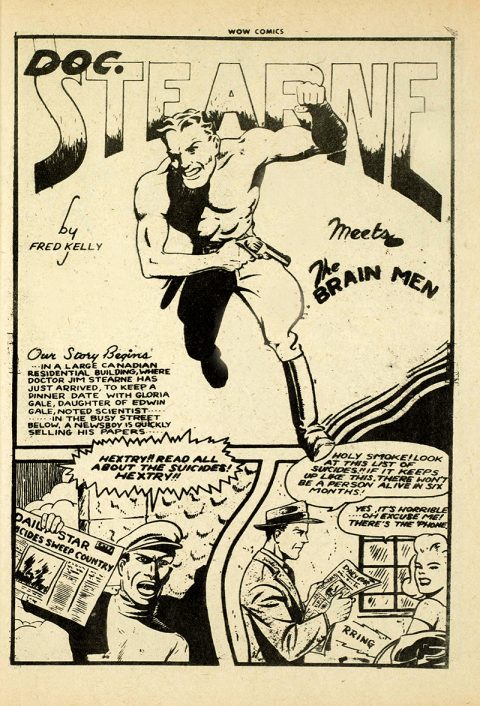
However, Doc Stearne’s story doesn’t end with Wow Comics No. 30, the last issue of the title. It continues in Commando Comics No. 21 and concludes in the last issue of Triumph Comics (No. 31) where Jim Stearne develops a powerful interest in the occult and decides to tackle demons and monsters from around the world in his new identity of Mr. Monster! This ‘title jumping’ probably tells us that Wow Comics was one of the first Bell titles to fold in late 1945 to early 1946 and that Triumph Comics was one of the last. Fred Kelly’s Mr. Monster, of course, had one more story to tell and this appeared in the May 1947 issue of Super Duper Comics No. 3 (the one Michael T. Gilbert found a coverless copy of in the mid-eighties and decided to revive Mr. Monster).
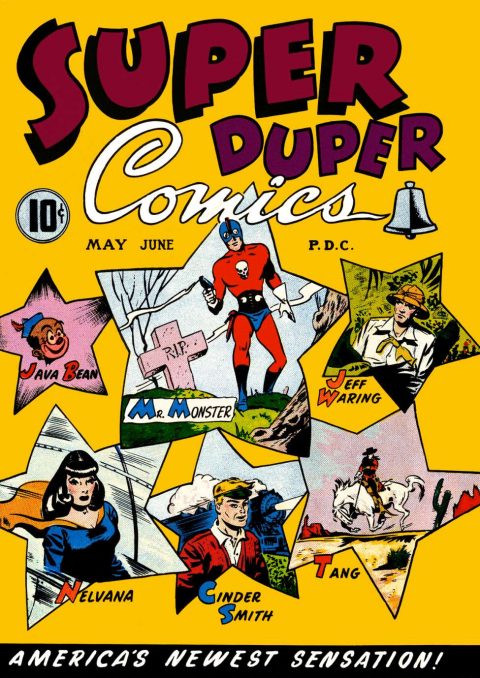
Bell Features’ legacy and the Wow Comics legacy, started by Edmund Legault in the summer of 1941 with Dart Daring and Whiz Wallace, actually concludes with Fred Kelly’s full-colour Mr. Monster story in Super-Duper Comics No. 3. This is after a short side-trip to a full-colour Slam-Bang Comics No. 7 (May 1946) where Murray Karn’s final Jeff Waring story and Adrian Dingle’s transformation of The Penguin into The Blue Raven appear. This is an unquestionably important legacy for Canadian comics and Edmund T. Legault was its central founding member.
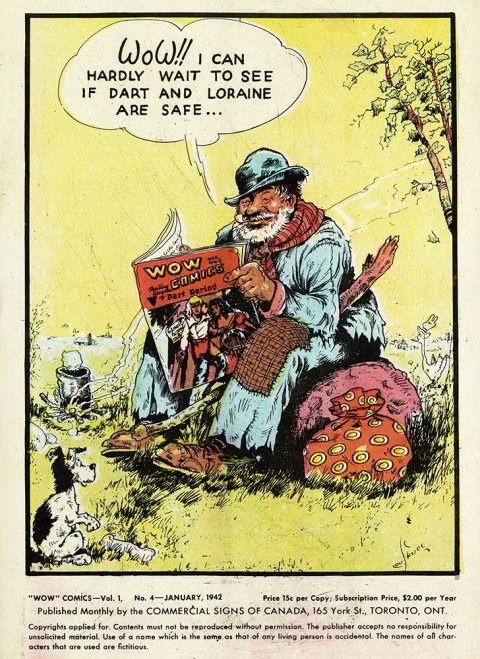
NEWS
Good friend and literate epicentre of comic knowledge and appreciation in the Tri-City area, Mel Taylor, is sharing some of his Canadian wartime comic collection with the community at Alfonso Espinos’ Studio Comix shop in the Frederick Street Mall in Kitchener this Saturday, July 20, from 10 am to 1 pm. Get there if you can. Mel has the best copy of the rare, but much sought-after, copy of the Nelvana of the Northern Lights compendium that I have seen. See it, and a few other WECA comics, first hand and chat with Mel about his comic book experiences and writing. Also, get him to sign some of his work.


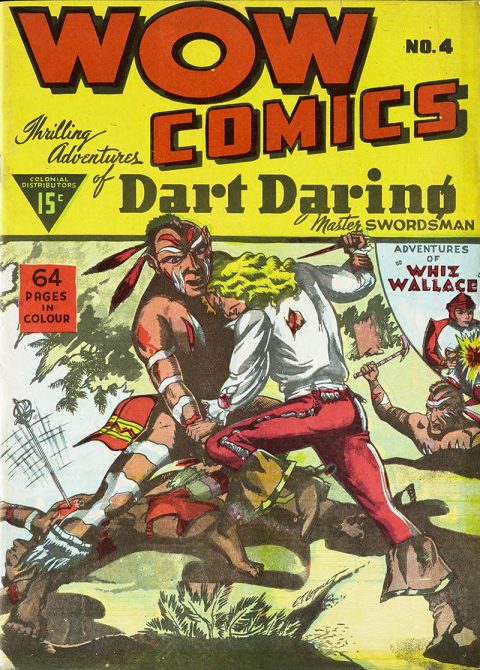
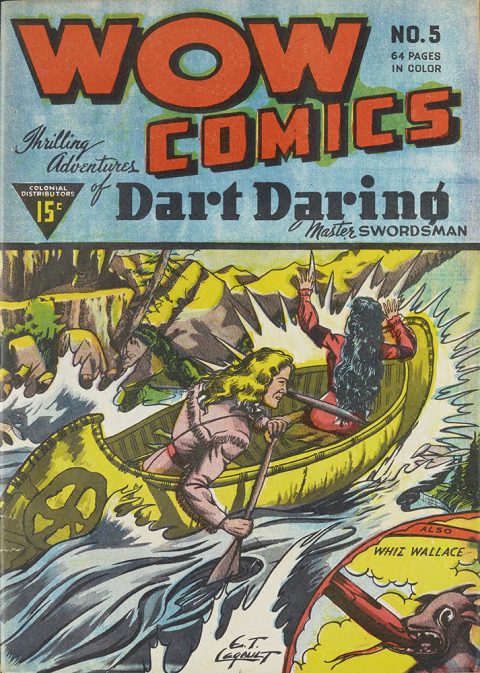



Ivan, the extent of your knowledge and research knows no bounds. I can’t wait for the next installment.
I love that photo of the signpainting workshop. The Dead March, narrated by the curiously-named Boake Carter, was released in 1937.
I wish it were hard to believe that the CGC grading (label) of Wow #17 could be so ignorant but unfortunately it is not. Still, a great article and a very strong warning to those who believe CGC to be gospel, whether it be grading or info.
Tony, thanks for the kind words. BK, sign-painting would have been such a common and valued occupation back then. Clayton Dexter (aka Howard Cowan), artist on the later Rex Baxter stories and creator of Salty Lane, also started off as a sign-painter. Robin, for me, slabbing of books has been reduced to idol worship–people need to wake up.
Ivan, once again I learn more about the era, this time Legault and Wow. I didn’t know Edmund Good worked on Wow, too, before his move to the U.S. comics market. I like his work a lot. Love those covers of Wow #4 ad #5.
I have to segway into a quick story. I’m here at San Diego Comic-Con right now, yesterday was opening day (and no, haven’t found any WECA books as yet, though I’m looking). Hope Nicholson, who your readers know compiled the Nelvana archive, has now done several books as Bedside Press and she’s of course also Canadian. She asked me to contribute to her latest book, Pros and (Comic) Cons, and it just came out from Dark Horse.
I wrote a piece (its prose AND comic book stories) about my very first drive to the east coast with my comics buddies in 1970, from San Jose, California to Multi-Con in Oklahoma City, and went on to our first SeulingCon in NYC. That’s when we first met and stayed with Phll Seuling for the first time.
Anyway….Previews wanted to do an interview about the book, so Hope and I were joined by Trina Robbins and Amy Chu for a foursome, with Previews’ Troy asking questions.
At one point Hope began explaining about the WECA era, and did a great job of telling WECA and how fascinating it is that the Capt. Marvel & other Fawcett stories were being redrawn in the Canadian titles. So I got to chime in, drop your name and your work on the two books, and explain once again about the popular misconception among so many comic fans about Canadian output being all about badly printed editions, post 1946 or ‘47 into the fifties.
So Troy takes this all in and then says, so you two, Hope and Bud, are both Canadians, right?
I took that as a high compliment while we explained, no, I’m from California. I had to laugh.
Troy should be interviewing YOU. Maybe for your Photo-Journal book, which Diamond certainly should handle. I’ll try and put in a good word for you, he mentioned he’s very interested in comics history and we may do a follow-up of some kind.
And a quick segway…Trina has written a book on Gladys Parker, the wonderful artist of Mopsy. Parker was not only beautiful herself, and hung with Hollywood film stars and celebrities, she also designed clothes for them and for herself. Hermes will be publishing this. I thought I could surprise Trina with the fact that Parker ghost-drew the syndicated Flying Jenny newspaper strip in the mid-forties. Fawcett artist Marc Swayze took it over completely after her run from 1942-44–he’d ghosted earlier strips, too. Creator Russell Keaton needed help after he enlisted, and then he died during the war. I only learned this because I bought an archive of original art, dailies and Sundays, and binders of proof sheets—they are beautiful—from the son of the WRITER of the strip, Glenn Chaffin. Chaffin also wrote the first Tailspin Tommy strips in 1929! But that’s yet another story.
Trina already knew that, and now I find its in Wikipedia, too.
There are WOW facsimilies for sale on eBay for about 20 bucks each. Are these sanctioned or swiped?
Bud, I’m glad that San Diego Con is still focusing on comic related panels and not mainly media franchise (Star Wars, Star Trek, Harry Potter….) like most cons up here seem to be. Hope has been a good champion of Canadian golden age comics and I’m glad her venture into publishing has gone well. I’ll be seeing her on July 26 when Ryerson University is trotting out its collection of over a 100 Bell Features comics as part of the Annual Canadian Comics Studies Society Conference held at Ryerson this year.
Thanks for the shout out on the panel and I’m still plodding along with the photo-journal of WECA covers project, but I’m finding it harder to get motivated with it than with my interviews book or the WECA Price Guide because the work on the photo-journal is a lot more ‘cutting and pasting’ assembly type work rather than journalistic research and writing. Because of that I tend to leave it for long periods of time. Will get there in the end though.
I look forward to reading your piece in the Pros and Cons collection, Bud. More needs to be written about the period of early comic collecting (60s-70s) and the fanzines and cons that kept it alive before we lose all the people who were there and can talk and write about it. My friend artist, letterer, and story teller supreme, Ron Kasman has a recent graphic novel trade out related to his early 1970s trip down to the NYC con called “The Tower of Comic Book Freaks” (Caliber Press) that is a treat to read. Thanks also for the Gladys Parker book reference. Trina has contributed so much to the knowledge of women creators in comics and is one of those people that has been there from the beginning of fandom in the 60s.
Thanks always for the support, Bud.
Klaus, almost all the WECA era comics now seem to be in the public domain. The records of copyright and the individuals that might enforce them don’t seem to be around though estates of some of the creators may be able to lay claim. Canadian war time comics are like a lost world, relatively unknown to most collectors and the public and more likely to be plundered for reprinting without consequence. I know that the Library and Archives of Canada has some sort of copyright on the Bell Features titles. This copyright was afforded to it as part of the purchase of the collection from Patrick Loubert and Michael Hirsh back in 1971 before the two went on to establish the Nelvana animation studios. About a year ago, I did inform the Library and Archives of Canada about the photocopied facsimiles being put up on eBay from the States but they seemed unable or uninterested in doing anything about them. The facsimiles of Wow Comics No. 1 and Dime Comics No. 26 put out by Bedside Press have been properly done and are the closest thing to legitimate facsimile products.
Another great article.Took me a second to realize the other Wow Comics was listed on your CGC label. Did they ever acknowledge the mistake?
Here’s hoping someone can successfully reproduce the entire run of WECA comics so that eferyone collecting them can have a complete set. If they could also arrange a royalty payment setup to the heirs of the creators too, that would be even better.
Peter, I’ve never informed CGC of the mistake. The important thing is that Gerald Lazare’s signature has been authenticated and you know what the comic is by looking at it. I’m keeping it this way to remind me of the limitations of CGC and because of the oddity it has created.
Klaus, there is work going on related to the scanning of all the WECA books available. Right now, my next project is to put a book together that has all the WECA covers in it in the style of Gerber’s Photo-Journals. That’s a step towards what you are talking about. The idea of royalty payments of some sort to estates/families of the creators is a good one, but it would be tremendously complicated to find all these heirs and set those payments up. The world of WECA creators is still pretty murky.
Any royalty payment to creators not currently known or available could be held in a trust for when they are discovered. Your covers project sounds great. I will buy one when it’s released. Thank you for your efforts with this. It would be fantastic to be able to buy a complete run of WECA comics in volumes.
Not only a gory cover on WOW No.1, sadistic acts engaged by natives on a white victim (who we can see is female, Dart must have trouble with his sight) but later on 1 1/2 pages depicting Loraine bathing in her “underwear”. I wonder if there was a black market among the kids for this issue? “Come on, trade ya 4 issues of Superman and Captain America for that Wow comic! Pleeeese!”
I see some swipes from Raymond’s Flash on the Whiz Wallace pages from Wow #2. I guess when you didn’t have access to models, comics and newspaper Sundays were the next best resource. At least they don’t appear to be direct tracings. Even Alex Raymond, grand illustrator that he is, did some swiping from Gustave Dore engravings.
The colouring is somewhat muted so I wonder if they were using diluted inks or more various % halftone screens (ie 70% or 55%) because of war time shortages. Certainly ends my conception of the Canadian Whites being not in colour. A full reprint run of WOW would be a blast – I have the legit reprint Hope did, ordered it just before I bought Ivan’s book.
Great article, Ivan, thanks. Re “slabbing”, weird to me but do you have another copy you can actually read?
Tim, the muted colouring on Wow Comics 1 was probably the limitation of the single colour press that Cy Bell’s Commercial Signs of Canada had and/or the access to inks that he had. The first issue of Better Comics, which had come out in Vancouver about six months earlier, had rich colouring on its “The Iron Man” feature, so either Vernon Miller had access to a better colour press or had better colour inks available. Also, I don’t feel so bad about slabbing Bell books because almost all of them have been digitized and made available to the public on the Library and Archives of Canada (LAC) website. The LAC digitized its collection of Bells back in 2016 and put them online so that you can read or download them as pdfs. The whole run of Wow Comics is there.
Maybe the LAC website is where the facsimile sellers got their source material from.
Thanks, Ivan! Hurray, I found the WOW Comics LAC page and how to use it (after about an hour of clicking on things). This is going to be great.
Ever since “that” book I’ve always wanted to read about our Penguin character. And now I can thanks to the downloadable files at the archive. Fantastic, done WOW, now working on Dime, saving them to a TBdrive so I can read them offline. Can’t figure a way to affordably print these out so digital comics it will have to be, but that works.